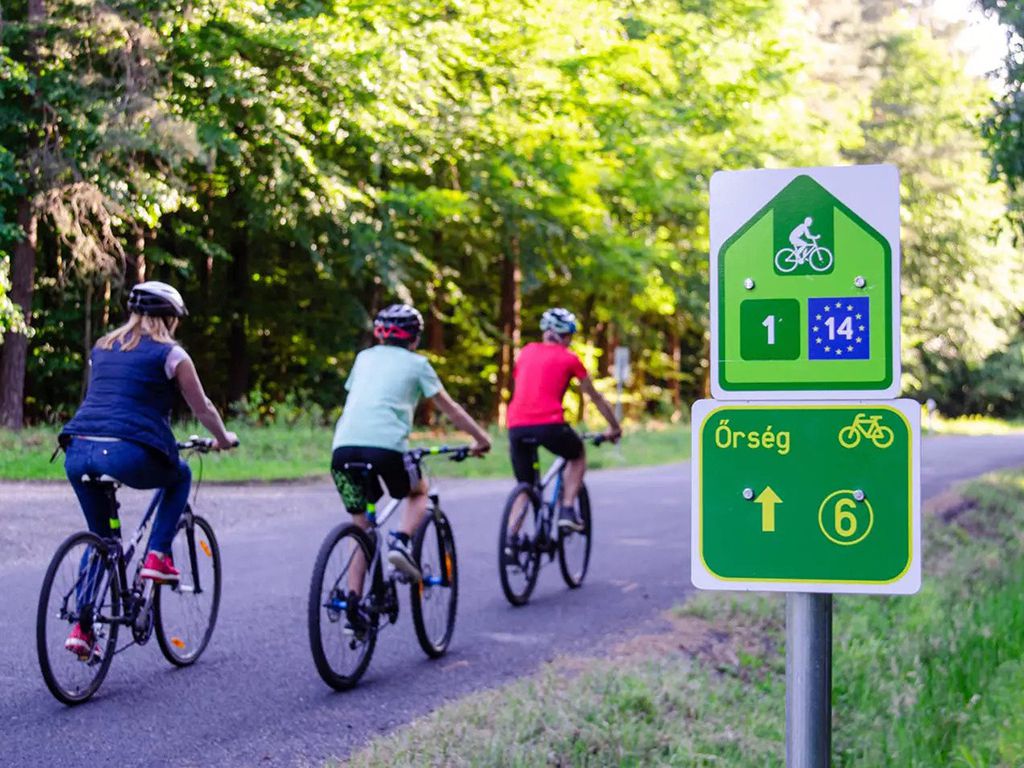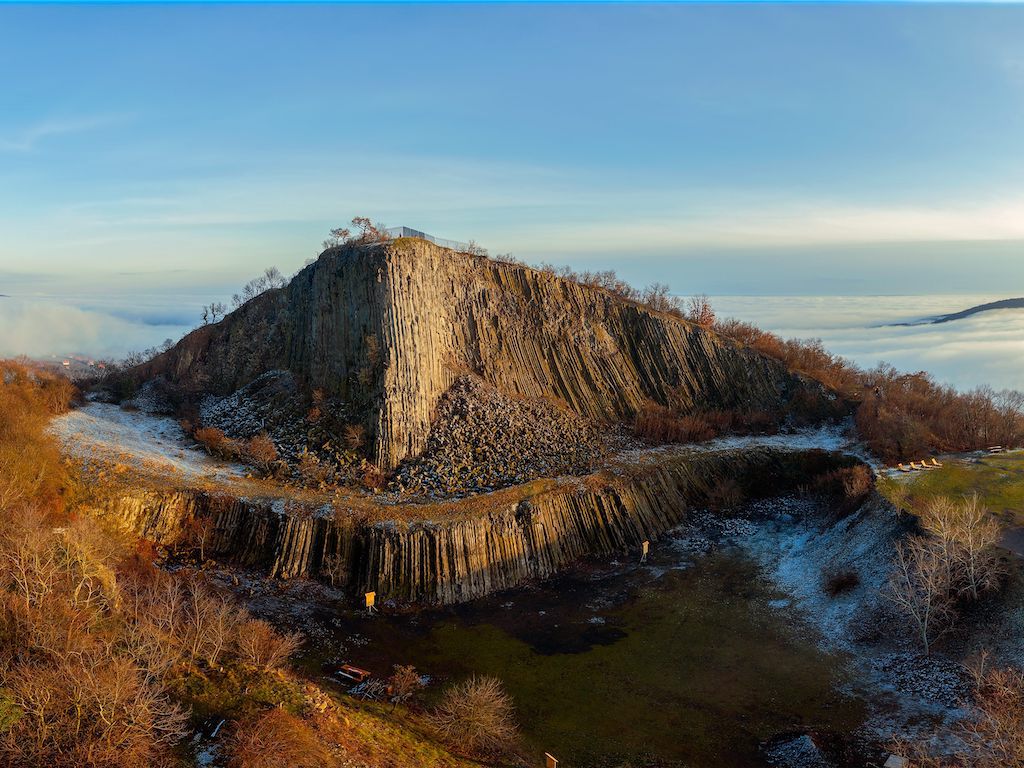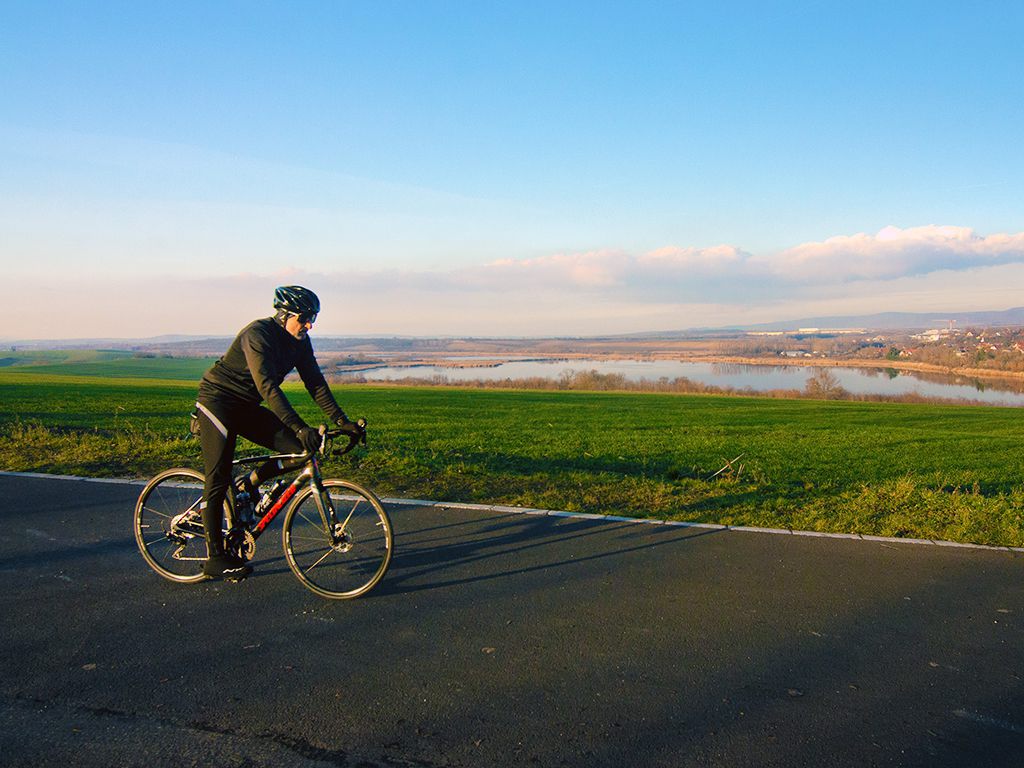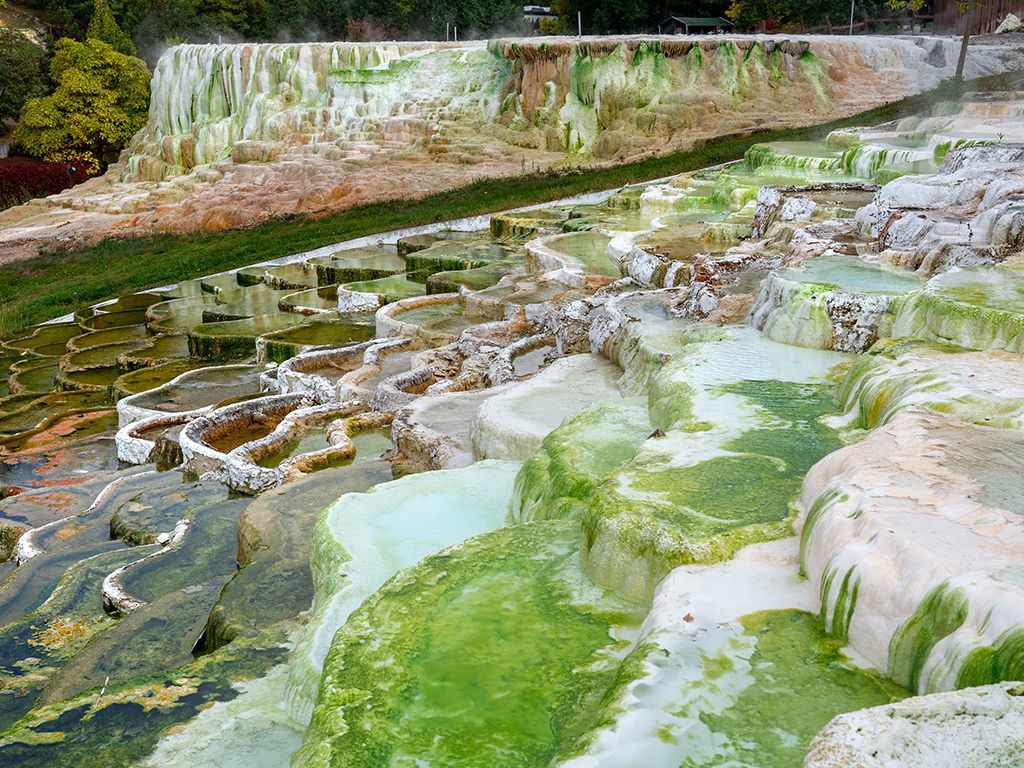 by Peter Illés on April 20th, 2023
by Peter Illés on April 20th, 2023
The Eurovelo 14 is the highest-numbered west-to-east route. Did you know odd-numbered Eurovelo routes run north to south, while even-numbered ones run west to east? It's called Waters of Central Europe, and its name definitely applies to the Hungarian stretch. If you decide to bike this section, you'll touch 3 of the 4 major lakes in Hungary (Lake Balaton, Lake Velence and Lake Tisza) and cross the 2 major rivers (Danube, Tisza).
It's also the last of the 4 different Eurovelo routes crossing Hungary (the others being EV6, EV11 and EV13, which we have all covered before).
As usual, I am going to break up the route into multiple sections so it is easier to follow:
You enter the country from Austria and follow a bike path through Szentgotthárd. From there, you turn south and follow quiet tarmac roads through the beautiful Őrség region. In Őriszentpéter, you turn east. After a couple of kilometres, the Eurovelo route starts a weird loop around Zalaegerszeg to avoid high-traffic roads.
The Őrség region officially ends at Őrimagyarósd. This is where the Kemeneshát starts, a peaceful and slightly hilly region of Hungary. You continue this loop north until Vasvár, where the route turns south again, through Zalabér and Zalaszentgrót, before reaching the shores of Lake Balaton. Apart from a short bike path through Zalaszentgrót and the final kilometres between Hévíz and Keszthely, you'll follow B-roads. Simple.
The baroque church in Szentgotthárd houses the largest bell in western Hungary. Alongside the church is a serene Cistercian Abbey that features a beautiful baroque garden, an ideal place to take a break and recharge for the journey ahead.
Moving on to Szalafő, you can visit the Pityerszeri skanzen. This open-air ethnographical museum showcases the locals' traditional architecture and way of life. You can also drop by the wild game reserve to glimpse the magnificent bison. And if you're looking for something a bit quirky, the town centre has an interesting ice pit that was once used to keep meat, beer, and wine cool during the hot summer months.
Őriszentpéter is the heart of the Őrség and home to an 800-year-old church with a fascinating history. The next village is Pankasz, with its unique "skirted" bell tower, which is a symbol of the Őrség region.
From here, it's a long stretch without any noteworthy sights. Just sit back, pedal away and enjoy the quiet roads. Your next stop should be Zalaszentgrót, which has a lovely 18th-century late-baroque castle with beautiful gardens that used to belong to the Batthyány family.
When you enter Hévíz, you already feel the lure of Lake Balaton. It's worth stopping, however, because the town is home to Europe's largest thermal lake. Go for a dip; it's open year-round.
The Őrség region offers a wide range of guesthouses and accommodations that cater to various preferences and budgets. If you're searching for a cosy and comfortable stay, you can Google "vendégház" to explore your options.
For a unique experience, you can head to Csaliti Vendégház in Farkasfa, which provides guesthouse and camping facilities, including a chance to spend the night in a traditional Hungarian yurt! Additionally, arranged camping places are available in Őriszentpéter or Hévíz.
Most of the Őrség is a national park, so it's not advisable to try wild camping there. In the Kemeneshát area, it should be reasonably easy to find secluded spots to set up your tent for the night.
Szentgotthárd, Vasvár, Zalaszentgrót and Hévíz are the larger towns in the region and the places for more significant shopping. Most other towns and villages have smaller grocery shops where you can grab quick snacks or drinks.
The Őrség region is a popular tourist destination. You'll find many great restaurants and inns to satisfy your hunger and indulge in hearty Hungarian meals.
There's a Bike & Coffee spot in Szentgotthárd where you can enjoy a cappuccino while the professionals repair your bike. Other bike shops can be found in Zalaszentgrót and Hévíz.

The EV14 in the Őrség region.
The EV14 route follows the northern shore of Lake Balaton for almost 100 kms. The last 2 kms stretch of the bike path was finished in April 2023, so this whole section is entirely traffic free. The condition of the cycling path leaves something to be desired, though, with tree roots gaping through the surface in many areas.
Lake Balaton is the favourite cycling (and holiday) destination for Hungarians. No wonder it's the closest thing we have to a sea. However, Lake Balaton offers much more than splashing around and sunbathing. It has hundreds of exciting sights, great cafés and restaurants, lookout towers and stunning views. Especially the northern shore, where the EV14 passes through. Lucky you!
Starting in Keszthely, ensure you don't miss the Festetics Castle. Built in baroque style during the 18th and 19th centuries, it boasts an exquisite 42-hectare garden, a coach museum, a great library and a 500-year-old wine cellar, whose galleries can be explored during a guided wine-tasting tour.
Next up is the remains of Szigliget castle, an important bastion against the Turkish invasion in the 16th century, sitting pretty on top of a volcanic cone. Soon after leaving Szigliget, you'll arrive in the Badacsony, an area famous for its white wines. The volcanic soil here gives the wines a distinct minerally character.
Folly Arboretum is a winery and botanical garden offering splendid lake views. It's a peaceful place to recharge your batteries.
The Káli Basin is a couple of kilometres away from the lake. Still, spending a day here is worth taking this short detour. Start at the ranch in Salföld before checking out the farmer's market in Káptalantóti, which is open on Sunday mornings. Trust me, it's an experience in itself.
Head on to Mindszentkálla and grab some lunch in the Káli-kapocs beer garden, which caters mainly to cyclists, before exploring the lovely village of Szentbékálla and the Sea of Stones. Head out and visit the majestic basalt columns of Hegyestű and finish your day in Köveskál tasting some of the great local wines.
You can rejoin the Balaton bike path and the EV14 at Révfülöp or Zánka. Your next major sight is the Tihany peninsula. Towering over Lake Balaton is the Benedictine Abbey, founded in the 11th century. The current church building was built in the 18th century in, you guessed it, baroque style. Hey, we Hungarians love our baroque 😜.
There are plenty of other minor highlights on the peninsula, such as the monk dwellings, the inner lakes or the lavender fields. It's also just a great place to wander around.
A couple of kilometres away is Balatonfüred, the centre of northern Balaton. It has a lovely marina, shady lakeside promenade, plenty of great cafés and restaurants and a vibrant nightlife.
The area between Balatonfüred and Balatonalmádi, especially the village of Csopak, is another important hotspot for wine lovers. Check out the many wineries perched on the hillside offering incredible vistas of Lake Balaton.
All-in-all, the Balaton is worth the hype. I recommend you enjoy it to the fullest, in slow riding style, spending at least 3 days here.
Make sure you check out our Sailboats, bikes and wines: Around the Balaton tour.
Since Lake Balaton is a tourist hotspot, it's got plenty of guesthouses and hotels. However, booking in advance is recommended, especially in the summer months.
Wild camping lakeside is virtually impossible and frowned upon, but plenty of arranged campsites exist. If you're adamant about wild camping, head into the Balaton highlands.
Again, being an area frequented by many tourists, there are grocery shops, bakeries, and cafés everywhere. Supermarkets are available in Keszthely, Balatonfüred and Balatonalmádi.
Bike shops are also available, even in smaller villages, catering to the many cyclists visiting the lake. There are also self-service bike repair spots arranged in some places with all the essential tools needed to repair your bike or change tyres.

The basalt columns of the Hegyestű towering over the Káli basin.
This section is called BuBa, after the BuBa bike path, which connects the capital, Budapest, with Lake Balaton. Hence the name BuBa. The bike path was inaugurated in 2022 and has become a local favourite.
It's safe, well-signposted and takes the scenic route. So expect short but steep climbs, especially between Lake Velence and the capital. The only exception is through the city of Székesfehérvár. Although bike paths lead through the city, they aren't always connected and aren't signposted, so getting lost is easy.
The BuBa end on the outskirts of Budapest. It might be a challenge to reach the city centre. I recommend the route BuBa endpoint -> Susulyka utca -> Kánai út -> Kapolcs utca -> Péterhegyi út and then follow the bike path downtown along Egér út, Borszéki utca and Bartók Béla út.
Székesfehérvár is one of the most important cities in Hungarian history. It was the crowning place for Hungarian kings from the establishment of the Kingdom of Hungary until the beginning of Ottoman rule in 1543. Nowadays it's got a vibrant town centre with exciting architecture and pleasant pedestrian streets.
On the outskirts of town, you can find the Bory-vár (Bory castle), also dubbed the Taj Mahal of Székesfehérvár. Built almost entirely by architect and sculptor Bory Jenő, it is a testament to his love for his muse and art. It entered the Guinness Book of Records as the largest building built by a single man.
Moving on from Székesfehérvár, you'll arrive at Lake Velence. I always thought of Lake Velence as a miniature Lake Balaton. It has a flat southern shore and a hilly northern shore, which is arguably more interesting.
Pákozd is home to an arboretum and safari park. Don't expect any elephants or giraffes, though. Instead, it has more endemic animals, like deer, wild boars and mouflons. In the hills between Pákozd and Sukoró, you'll be able to stumble upon an interesting geological phenomenon in the form of the Ingókövek. Literally translated as pendulous rocks or wobbly rocks, these are some giant stones that look like they will fall over at any moment. If you take these little detours, be aware that the paths around the rocks are more suitable for MTBs.
Budapest is a favourite destination for filmmakers because it's a budget-friendly location. As such, many facilities have been built around the capital. The film studios in Etyek and the western town in Tordas are very close to the BuBa and are must-visits for film buffs.
By now, you must've sensed that I am a wine guy. Etyek is also famous for its wines. Also called Budapest's vineyards, plenty of charming wine cellars await wine lovers.
Make sure you check out our Etyek wine region tour.
Your final sight along the BuBa is the railway viaduct in Biatorbágy. It was once the scene of the country's largest train bombing. Today, the BuBa cycling path crosses it, making it a favourite photo spot.
Next up, Budapest! Since there are countless resources about Budapest, I will not include a description here. But allow yourself 3 or 4 days to fully explore it.
Guesthouses will be easy to find along Lake Velence, Székesfehérvár or even Etyek.
Wild camping is also possible along this stretch, although it gets more complicated after Etyek. I would also avoid the area around Lake Velence, especially as there is an arranged camping spot in Velence called Pagony!
Székesfehérvár and Budapest have everything you need, from supermarkets to shopping malls and sporting goods stores.
Lake Velence also has plenty of grocery stores and restaurants. Most other villages will have well-provisioned grocery stores.
Many bike shops are also available on the way, with several in Székesfehérvár, one in Velence and two each in Biatorbágy and Törökbálint. Needless to say, Budapest has too many to count.

The BuBa doesn't always take the direct route, but it is surely scenic.
The Eurovelo website recommends taking the train from Keleti railway station to avoid the heavy traffic between Budapest and Gödöllő, as there is no bike path on this stretch. I would, however, recommend you follow Kerepesi út and Veres Péter út, then turn right and follow the Szilas stream until Lake Naplás. This route is mainly on arranged bike paths and is completely manageable.
The Szilas cycling path is only a couple of years old. Lake Naplás, where it ends, quickly became a favourite weekend destination for occasional riders. You can ride through Nagytarcsa and Isaszeg before rejoining the official Eurovelo route in Gödöllő. You can avoid Gödöllő altogether, and from Isaszeg, proceed directly to Zsámbok. This part of the route goes through the Gödöllő hills, which are part of the Cserhát mountain range.
You will continue riding on secondary roads with medium traffic, crossing the town of Hatvan before turning east and following the Mátra mountain range until the city of Eger. Don't expect many bike paths along this stretch, although you will sporadically find yourself on one.
From Eger, there's a big climb towards Noszvaj before turning south on an excellent 10 kms section of bike path between Bogács and Mezőkövesd. This path takes you gently downhill towards Lake Tisza and The Great Plains, entering the final section of the EV14.
Gödöllő is famous for the Royal Palace. Initially built for the Grassalkovich family in the 18th century, it became the summer residence for Emperor Franz Josef and his wife, Sisi. After this line of the Grassalkovich family died out, the palace was bought for the crown. Constructed in baroque and rococo styles, the palace and adjacent gardens were famously the favourite residence of Empress Elisabeth.
The Grassalkovics family had another castle in the next town, Hatvan. It shares many characteristics in architecture and style with its more famous counterpart. It is nevertheless more low-key. Nowadays, it hosts the Hungarian Hunting Museum.
The southern slopes of the Mátra are also a tremendous wine-growing region of Hungary, especially the villages of Gyöngyöspata, Gyöngyöstarján and Gyöngyössolymos. It's worth looking to your left as you pass through Gyöngyöspata and try to spot the "Seven Row Cellar Village", the ancient cellar rows perched on the hill above the modern village.
Mátrafüred is a tiny resort town on the south slopes of the Mátra. This is where the climb starts towards Hungary's longest climb to its highest point, the Kékestető. At 1014 metres above sea level, it's tiny compared to Europe's legendary cycling summits. The last 3.5 kilometres, however, average out at 8% incline, with some parts at 13%. The entire length of the climb is 17 kms with 830 metres in elevation.
The last sight on this stretch of the EV14 is Eger. But just before entering this city, you'll pass through the spa town of Egerszalók. You can swim in the hot springs and admire the salt hill, a series of cascades over travertine slabs.
The historic city of Eger is famous for its 16th-century castle, a Turkish minaret, charming old town, the grand basilica and, of course, its wine. Yes, Eger is also a wine region, your 5th one already during the Eurovelo 14 in Hungary (which has 22 distinct wine regions, in fact). The most famous is, of course, the Bulls Blood, or Egri Bikavér. This classic local table wine nowadays evolved into a well-regulated cuvée. But I urge you to also taste other wines on the offering. Eger is known as Hungary's Burgundy, after all.
The best places for a wine tasting are Kovács Nimród's winery or Tóth Ferenc and St. Andrea in the Szépasszonyvölgy, a valley with over 200 wineries and cellars.
Noszvaj is a steep climb away from Eger. Together with nearby Szomolya and Cserépfalu, these villages are famous for their cave dwellings and the mysterious rock columns called beehive stones.
Check out Eger and Noszvaj during our Tour de Bükk cycling tour.
Arranged camping spots can be found at Sástó, just above Mátrafüred, Eger and Mezőkövesd. If you prefer wild camping, your best bet is between Mátrafüred and Eger.
Guesthouses and hotels are available in every major town. My recommendation would be to stay either in Mátrafüred or Eger.
Gödöllő, Hatvan, Gyöngyös, Eger and Mezőkövesd are all larger towns with several supermarkets and bike shops.

Don't miss the Salt Hill in Egerszalók.
From Mezőkövesd, you will follow backroads until Lake Tisza, crossing the Tisza River over a spectacular series of purpose-built cycling bridges. Between Tiszafüred and Hortobágy, the EV14 tries to avoid the busy #33 state road. Instead, it takes you on a few tractor roads that are pretty bumpy and muddy after heavy rains.
It's B-roads again until Balmazújváros, from where you can reach Debrecen on bike paths, except for the last 10 kms, which take you on a mix of tarmac and unpaved roads.
Lake Tisza, also known as the Kisköre reservoir, is the largest artificial lake in Hungary and a popular destination for local cyclists. Although the EV14 only passes north of the lake, the circuit is 60 kms long and worth doing. The Lake Tisza Ökocentrum in Poroszló has a large freshwater aquarium, water walkways and lookout towers. Exploring the meanders by canoe or boat is a must-do at Lake Tisza.
The Hortobágy National Park, a UNESCO World Heritage Site since 1999, is an area made up of steppe grasslands and marshlands and is an excellent spot for birdwatching. You can go on a puszta safari (puszta is what we call the steppe grasslands) or a carriage ride showing you the traditional way of life, folklore and livestock of the Great Hungarian Plains. It's worth spending a day each around Lake Tisza and in the Hortobágy.
The EV14 ends in Debrecen, the largest town in Eastern Hungary. Debrecen is an important university town, with a lovely old town dominated by the largest reformed church in the country.
The villages around Lake Tisza and the Hortobágy have many options for an overnight stay. I know of one camping spot on this stretch in Hortobágy. I would avoid wild camping as most of this stretch takes you through a national park.
The Tisza-tavi Kerékpáros Centrum (Lake Tisza Cycling Centre) in Tiszafüred is mainly geared towards bike rentals. Still, they also offer mobile bike service in the region if you have any trouble. Apart from that, you have bike repair shops in Balmazújváros and Debrecen.
Lake Tisza and Hortobágy have many restaurants where you can get an excellent traditional Hungarian meal. I really recommend Lila Akác in Abádszalók. Well-supplied grocery shops are also available.
Hypermarkets and sporting goods stores are available in Debrecen only.

Resting at Lake Tisza.